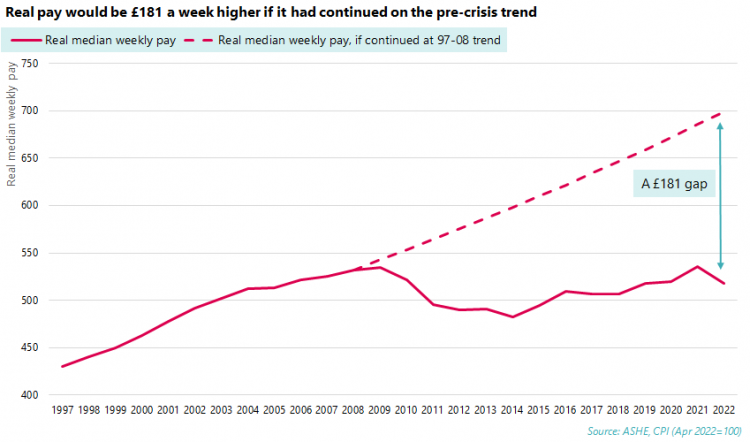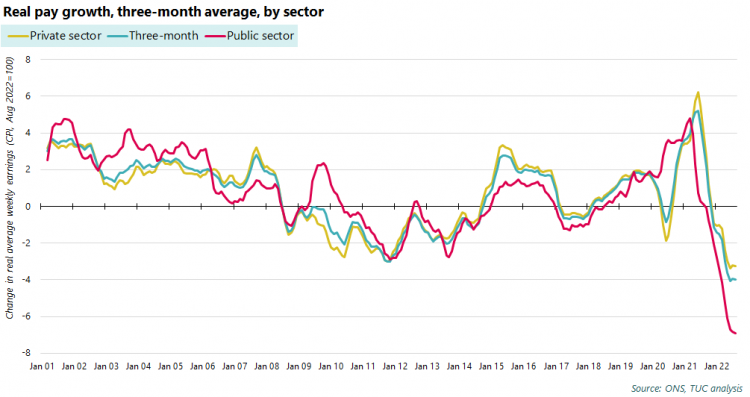
The new prime minister must get pay rising
The 14-year pay squeeze continues
New data from the Annual Survey of Hours and Earnings (ASHE), released today, shows that real weekly wages in April 2022 were down by £15 compared to 2008. This is the continuation of a pay squeeze that’s now into its fourteenth year.
Before 2008, real wages typically grew by around 2 per cent each year. If real wages had continued to grow at this pace between 2008 and 2022, they’d now be £181 per week higher than they are.
ASHE is the most comprehensive data on pay in the UK. It’s released each October, based on data collected in the previous April.
Average Weekly Earnings (AWE) data, which is more timely but less comprehensive, shows that the pay situation has worsened since April, when ASHE data is collected. The latest AWE data, released earlier this month and covering up to August 2022, shows that real wages were down £23 per week (4 per cent) compared to same month last year.
Falling real pay is particularly hitting public sector workers, where real wage growth has hit a new record low (-6.9 per cent) and weekly wages are down £43 (or a massive £185 per month).
Low pay in the UK
ASHE shows that just over half of workers earn below £15 an hour. It also shows that, in 2022, 12.2 per cent of employees were earning less than a Real Living Wage (as set by the Living Wage Foundation). Around half a million employees (509,000, or 1.7 per cent of employees) earn below the legal minimum wage.
There’s a lot of regional variation when it comes to percentage of workers earning less than the real living wage. In some areas over 3-in-10 employees aren’t earning enough to live on. These include Haringey (34.2 per cent), Bexley (33.1 per cent) and Redbridge (31.9 per cent). Outside of London, the highest proportions are in South Staffordshire (25.9 per cent), Redcar and Cleveland (24.0 per cent) and Forest of Dean (23.4 per cent).
There are gender differences too. Women are more likely to both earn less than a Real Living Wage (14.6 per cent compared to 9.9 per cent) and earn less than the legal minimum (2.1 per cent compared to 1.4 per cent).
Gender pay gap
Gender inequality is also clear when we look at the gender pay gap. Women earn 14.9 per cent less than men, with the gap narrow among younger workers and wider among workers aged 40 and over.
The overall gap is narrowing, but progress is slow. If it continues to close as its current rate, it won’t disappear until 2044.
Tackling stagnant pay and the gender pay gap
The pay squeeze has already lasted for 14 years and it looks set to continue for years more. This is the longest, harshest squeeze in living memory. The new prime minister must tackle this as a priority.
We need a government that will boost the minimum wage to £15 an hour as soon as possible, fund decent pay rises for all public sector workers and introduce fair pay agreements for whole industries.
And bolder action is needed to tackle the gender pay gap. Companies must be legally required to explain how they’ll close their gender pay gaps and should face fines if they continue to discriminate against women. Alongside this, we need:
- Free, high-quality childcare, available to all. This would begin from the point where paid maternity or parental leave ends.
- A day one right to flexible working and for employers to advertise jobs as flexible upfront.
- The overhaul of shared parental leave based on day one, individual, non-transferable rights to time off for each parent, on a use it or lose it basis for all workers and paid at a liveable rate.
- Stronger maternity and paternity leave rights for all workers, regardless of employment status.
Stay Updated
Want to hear about our latest news and blogs?
Sign up now to get it straight to your inbox


